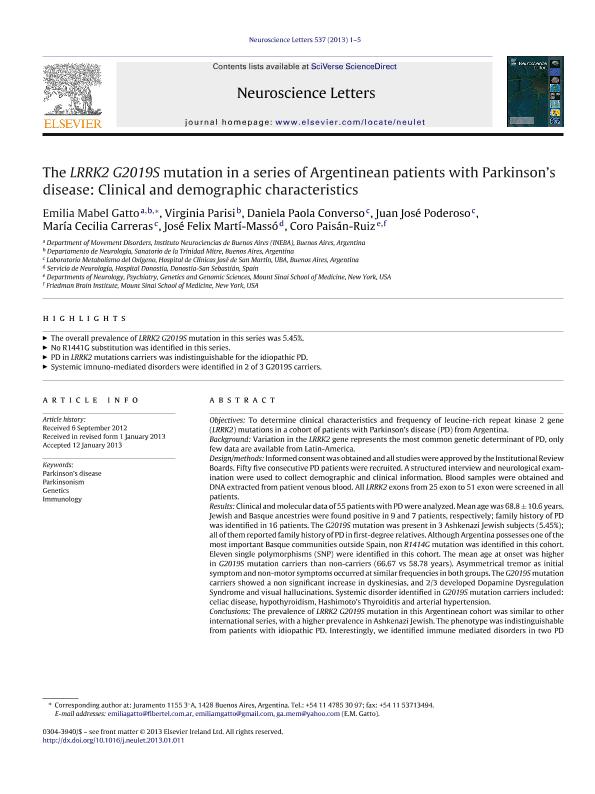Mostrar el registro sencillo del ítem
dc.contributor.author
Gatto, Emilia Mabel

dc.contributor.author
Parisi, Virginia

dc.contributor.author
Converso, Daniela Paola

dc.contributor.author
Poderoso, Juan José

dc.contributor.author
Carreras, Maria Cecilia

dc.contributor.author
Martí Massó, José Félix

dc.contributor.author
Paisán Ruiz, Coro

dc.date.available
2017-06-21T20:57:19Z
dc.date.issued
2013-03
dc.identifier.citation
Gatto, Emilia Mabel; Parisi, Virginia; Converso, Daniela Paola; Poderoso, Juan José; Carreras, Maria Cecilia; et al.; The LRRK2 G2019S mutation in a series of Argentinean patients with Parkinson's disease: Clinical and demographic characteristics; Elsevier Ireland; Neuroscience Letters; 537; 3-2013; 1-5
dc.identifier.issn
0304-3940
dc.identifier.uri
http://hdl.handle.net/11336/18606
dc.description.abstract
OBJECTIVES: To determine clinical characteristics and frequency of leucine-rich repeat kinase 2 gene (LRRK2) mutations in a cohort of patients with Parkinson's disease (PD) from Argentina. BACKGROUND: Variation in the LRRK2 gene represents the most common genetic determinant of PD, only few data are available from Latin-America. DESIGN/METHODS: Informed consent was obtained and all studies were approved by the Institutional Review Boards. Fifty five consecutive PD patients were recruited. A structured interview and neurological examination were used to collect demographic and clinical information. Blood samples were obtained and DNA extracted from patient venous blood. All LRRK2 exons from 25 exon to 51 exon were screened in all patients. RESULTS: Clinical and molecular data of 55 patients with PD were analyzed. Mean age was 68.8±10.6 years. Jewish and Basque ancestries were found positive in 9 and 7 patients, respectively; family history of PD was identified in 16 patients. The G2019S mutation was present in 3 Ashkenazi Jewish subjects (5.45%); all of them reported family history of PD in first-degree relatives. Although Argentina possesses one of the most important Basque communities outside Spain, non R1414G mutation was identified in this cohort. Eleven single polymorphisms (SNP) were identified in this cohort. The mean age at onset was higher in G2019S mutation carriers than non-carriers (66.67 vs 58.78 years). Asymmetrical tremor as initial symptom and non-motor symptoms occurred at similar frequencies in both groups. The G2019S mutation carriers showed a non significant increase in dyskinesias, and 2/3 developed Dopamine Dysregulation Syndrome and visual hallucinations. Systemic disorder identified in G2019S mutation carriers included: celiac disease, hypothyroidism, Hashimoto's Thyroiditis and arterial hypertension. CONCLUSIONS: The prevalence of LRRK2 G2019S mutation in this Argentinean cohort was similar to other international series, with a higher prevalence in Ashkenazi Jewish. The phenotype was indistinguishable from patients with idiopathic PD. Interestingly, we identified immune mediated disorders in two PD patients carrying the G2019S mutation. Within this context, recent studies have identified full-length LRRK2 as a relatively common constituent of many cell types in the immune system including human peripheral blood mononuclear cells. Nevertheless, a casual association could not be excluded and the analysis of more extensive series is required.
dc.format
application/pdf
dc.language.iso
eng
dc.publisher
Elsevier Ireland

dc.rights
info:eu-repo/semantics/openAccess
dc.rights.uri
https://creativecommons.org/licenses/by-nc-nd/2.5/ar/
dc.subject
Parkinson'S Disease
dc.subject
Parkinsonism
dc.subject
Genetics
dc.subject
Immunology
dc.subject.classification
Neurociencias

dc.subject.classification
Medicina Básica

dc.subject.classification
CIENCIAS MÉDICAS Y DE LA SALUD

dc.title
The LRRK2 G2019S mutation in a series of Argentinean patients with Parkinson's disease: Clinical and demographic characteristics
dc.type
info:eu-repo/semantics/article
dc.type
info:ar-repo/semantics/artículo
dc.type
info:eu-repo/semantics/publishedVersion
dc.date.updated
2017-06-21T17:38:37Z
dc.identifier.eissn
1872-7972
dc.journal.volume
537
dc.journal.pagination
1-5
dc.journal.pais
Irlanda

dc.journal.ciudad
Shannon
dc.description.fil
Fil: Gatto, Emilia Mabel. Instituto de Neurociencias Buenos Aires S. A.; Argentina. Sanatorio de la Trinidad Mitre; Argentina
dc.description.fil
Fil: Parisi, Virginia. Sanatorio de la Trinidad Mitre; Argentina
dc.description.fil
Fil: Converso, Daniela Paola. Universidad de Buenos Aires. Facultad de Medicina. Hospital de Clínicas General San Martín. Laboratorio de Metabolismo del Oxígeno; Argentina. Consejo Nacional de Investigaciones Científicas y Técnicas; Argentina
dc.description.fil
Fil: Poderoso, Juan José. Universidad de Buenos Aires. Facultad de Medicina. Hospital de Clínicas General San Martín. Laboratorio de Metabolismo del Oxígeno; Argentina. Consejo Nacional de Investigaciones Científicas y Técnicas; Argentina
dc.description.fil
Fil: Carreras, Maria Cecilia. Universidad de Buenos Aires. Facultad de Medicina. Hospital de Clínicas General San Martín. Laboratorio de Metabolismo del Oxígeno; Argentina. Consejo Nacional de Investigaciones Científicas y Técnicas; Argentina
dc.description.fil
Fil: Martí Massó, José Félix. Hospital Donostia; España
dc.description.fil
Fil: Paisán Ruiz, Coro. Icahn School of Medicine at Mount Sinai; Estados Unidos
dc.journal.title
Neuroscience Letters

dc.relation.alternativeid
info:eu-repo/semantics/altIdentifier/url/http://www.sciencedirect.com/science/article/pii/S0304394013000311
dc.relation.alternativeid
info:eu-repo/semantics/altIdentifier/doi/http://dx.doi.org/10.1016/j.neulet.2013.01.011
Archivos asociados
